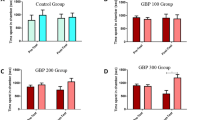Abstract
Rationale
Acute antipsychotic treatment disrupts conditioned avoidance responding, and repeated treatment induces a sensitization- or tolerance-like effect. However, the neurochemical mechanisms underlying both acute and repeated antipsychotic effects remain to be determined.
Objective
The present study examined the neuroreceptor mechanisms of haloperidol, clozapine, and olanzapine effect in a rat two-way conditioned avoidance model.
Methods
Well-trained Sprague–Dawley rats were administered with haloperidol (0.05 mg/kg, sc), clozapine (10.0 mg/kg, sc), or olanzapine (1.0 mg/kg, sc) together with either saline, quinpirole (a selective dopamine D2/3 agonist, 1.0 mg/kg, sc), or 2,5-dimethoxy-4-iodo-amphetamine (DOI; a selective 5-HT2A/2C agonist, 2.5 mg/kg, sc), and their conditioned avoidance responses were tested over 3 days. After 2 days of drug-free retraining, the repeated treatment effect was assessed in a challenge test.
Results
Pretreatment of quinpirole, but not DOI, attenuated the acute haloperidol-induced disruption of avoidance responding and to a lesser extent, olanzapine-induced disruption. In contrast, pretreatment of DOI, but not quinpirole, attenuated the acute effect of clozapine. On the repeated effect, pretreatment of DOI, but not quinpirole, attenuated the potentiated disruption of haloperidol, whereas pretreatment of quinpirole attenuated the potentiated disruption of olanzapine but enhanced the tolerance-like effect of clozapine.
Conclusions
These findings suggest that acute haloperidol and olanzapine disrupt avoidance responding primarily by blocking dopamine D2 receptors, whereas acute clozapine exerts its disruptive effect primarily by blocking the 5-HT2A receptors. The repeated haloperidol effect may be mediated by 5-HT2A/2C blockade-initiated neural processes, whereas the repeated clozapine and olanzapine effect may be mediated by D2/3 blockade-initiated neural processes.








Similar content being viewed by others
References
Amato D, Stasi MA, Borsini F, Nencini P (2008) Haloperidol both prevents and reverses quinpirole-induced nonregulatory water intake, a putative animal model of psychogenic polydipsia. Psychopharmacology (Berl) 200:157–165
Arnt J (1982) Pharmacological specificity of conditioned avoidance response inhibition in rats: inhibition by neuroleptics and correlation to dopamine receptor blockade. Acta Pharmacol Toxicol (Copenh) 51:321–329
Atkins JB, Chlan-Fourney J, Nye HE, Hiroi N, Carlezon WA Jr, Nestler EJ (1999) Region-specific induction of deltaFosB by repeated administration of typical versus atypical antipsychotic drugs. Synapse 33:118–128
Benaliouad F, Kapur S, Rompre PP (2007) Blockade of 5-HT2a receptors reduces haloperidol-induced attenuation of reward. Neuropsychopharmacology 32:551–561
Bolles RC (1970) Species-specific defense reactions and avoidance learning. Psychol Rev 77:32–48
Bonaccorso S, Meltzer HY, Li Z, Dai J, Alboszta AR, Ichikawa J (2002) SR46349-B, a 5-HT(2A/2C) receptor antagonist, potentiates haloperidol-induced dopamine release in rat medial prefrontal cortex and nucleus accumbens. Neuropsychopharmacology 27:430–441
Browning JL, Patel T, Brandt PC, Young KA, Holcomb LA, Hicks PB (2005) Clozapine and the mitogen-activated protein kinase signal transduction pathway: implications for antipsychotic actions. Biol Psychiatry 57:617–623
Buckland PR, D’Souza U, Maher NA, McGuffin P (1997) The effects of antipsychotic drugs on the mRNA levels of serotonin 5HT2A and 5HT2C receptors. Brain Res Mol Brain Res 48:45–52
Caine SB, Geyer MA, Swerdlow NR (1995) Effects of D3/D2 dopamine receptor agonists and antagonists on prepulse inhibition of acoustic startle in the rat. Neuropsychopharmacology 12:139–145
Davies JA, Redfern PH (1974) The interaction of dopamine-antagonists and amantadine hydrochloride on the acquisition of the conditioned avoidance response in rats. Neuropharmacology 13:941–948
Dragunow M, Robertson GS, Faull RL, Robertson HA, Jansen K (1990) D2 dopamine receptor antagonists induce fos and related proteins in rat striatal neurons. Neuroscience 37:287–294
Elliott PJ, Walsh DM, Close SP, Higgins GA, Hayes AG (1990) Behavioural effects of serotonin agonists and antagonists in the rat and marmoset. Neuropharmacology 29:949–956
Goudie AJ, Cole JC, Sumnall HR (2007a) Olanzapine and JL13 induce cross-tolerance to the clozapine discriminative stimulus in rats. Behav Pharmacol 18:9–17
Goudie AJ, Cooper GD, Cole JC, Sumnall HR (2007b) Cyproheptadine resembles clozapine in vivo following both acute and chronic administration in rats. J Psychopharmacol 21:179–190
Granoff MI, Ashby CR Jr (1998) The effect of the repeated administration of the compound 3, 4-methylenedioxymethamphetamine on the response of rats to the 5-HT2A, C receptor agonist (+/−)-1-(2, 5-dimethoxy-4-iodophenyl)-2-aminopropane (DOI). Neuropsychobiology 37:36–40
Grauer SM, Graf R, Navarra R, Sung A, Logue SF, Stack G, Huselton C, Liu Z, Comery TA, Marquis KL, Rosenzweig-Lipson S (2009) WAY-163909, a 5-HT2C agonist, enhances the preclinical potency of current antipsychotics. Psychopharmacology (Berl) 204:37–48
Halberstadt AL, van der Heijden I, Ruderman MA, Risbrough VB, Gingrich JA, Geyer MA, Powell SB (2009) 5-HT(2A) and 5-HT(2C) receptors exert opposing effects on locomotor activity in mice. Neuropsychopharmacology 34:1958–1967
Hawkins MF, Uzelac SM, Hearn JK, Baumeister AA (2008) Effects of selective serotonin2 ligands on behaviors evoked by stress in the rat. Pharmacol Biochem Behav 90:632–639
Hillegaart V, Estival A, Ahlenius S (1996) Evidence for specific involvement of 5-HT1A and 5-HT2A/C receptors in the expression of patterns of spontaneous motor activity of the rat. Eur J Pharmacol 295:155–161
Ichikawa J, Dai J, Meltzer HY (2001) DOI, a 5-HT2A/2C receptor agonist, attenuates clozapine-induced cortical dopamine release. Brain Res 907:151–155
Kapur S, Seeman P (2001) Does fast dissociation from the dopamine d(2) receptor explain the action of atypical antipsychotics?: a new hypothesis. Am J Psychiatry 158:360–369
Kapur S, Wadenberg ML, Remington G (2000) Are animal studies of antipsychotics appropriately dosed? Lessons from the bedside to the bench. Can J Psychiatry 45:241–246
Kapur S, VanderSpek SC, Brownlee BA, Nobrega JN (2003) Antipsychotic dosing in preclinical models is often unrepresentative of the clinical condition: a suggested solution based on in vivo occupancy. J Pharmacol Exp Ther 305:625–631
Krebs-Thomson K, Geyer MA (1996) The role of 5-HT(1A) receptors in the locomotor-suppressant effects of LSD: WAY-100635 studies of 8-OH-DPAT, DOI and LSD in rats. Behav Pharmacol 7:551–559
Levis DJ, Brewer KE (2001) The neurotic paradox: attempts by two-factor fear theory and alternative avoidance models to resolve the issues associated with sustained avoidance responding in extinction. In: Mowrer RR, Klein SB (eds) Handbook of contemporary learning theories. Lawrence Erlbaum, Mahwah, pp 561–597
Li M, Davidson P, Budin R, Kapur S, Fleming AS (2004) Effects of typical and atypical antipsychotic drugs on maternal behavior in postpartum female rats. Schizophr Res 70:69–80
Li M, Fletcher PJ, Kapur S (2007) Time course of the antipsychotic effect and the underlying behavioral mechanisms. Neuropsychopharmacology 32:263–272
Li M, He W, Mead A (2009a) An investigation of the behavioral mechanisms of antipsychotic action using a drug-drug conditioning paradigm. Behav Pharmacol 20:184–194
Li M, He W, Mead A (2009b) Olanzapine and risperidone disrupt conditioned avoidance responding in phencyclidine-pretreated or amphetamine-pretreated rats by selectively weakening motivational salience of conditioned stimulus. Behav Pharmacol 20:84–98
Mead A, Li M (2009) Avoidance-suppressing effect of antipsychotic drugs is progressively potentiated after repeated administration: an interoceptive drug state mechanism. J Psychopharmacol 24:1045–1053
Mead A, Li M, Kapur S (2008) Clozapine and olanzapine exhibit an intrinsic anxiolytic property in two conditioned fear paradigms: contrast with haloperidol and chlordiazepoxide. Pharmacol Biochem Behav 90:551–562
Meltzer H (2002) Mechanisms of action of atypical antipsychotic drugs. In: Davis KL, Charney D, Coyle JT, Nemeroff C (eds) Neuropsychopharmacology the fifth generation of progress: an official publication of the American College of Neuropsychopharmacology. Lippincott Williams & Wilkins, Philadelphia
Meltzer HY, Matsubara S, Lee JC (1989) The ratios of serotonin2 and dopamine2 affinities differentiate atypical and typical antipsychotic drugs. Psychopharmacol Bull 25:390–392
Meltzer HY, Li Z, Kaneda Y, Ichikawa J (2003) Serotonin receptors: their key role in drugs to treat schizophrenia. Prog Neuropsychopharmacol Biol Psychiatry 27:1159–1172
Miyamoto S, Duncan GE, Marx CE, Lieberman JA (2005) Treatments for schizophrenia: a critical review of pharmacology and mechanisms of action of antipsychotic drugs. Mol Psychiatry 10:79–104
Moran-Gates T, Gan L, Park YS, Zhang K, Baldessarini RJ, Tarazi FI (2006) Repeated antipsychotic drug exposure in developing rats: dopamine receptor effects. Synapse 59:92–100
Ninan I, Kulkarni SK (1999) Quinpirole, 8-OH-DPAT and ketanserin modulate catalepsy induced by high doses of atypical antipsychotics. Meth Find Exp Clin Pharmacol 21:603–608
Olsen CK, Brennum LT, Kreilgaard M (2008) Using pharmacokinetic-pharmacodynamic modelling as a tool for prediction of therapeutic effective plasma levels of antipsychotics. Eur J Pharmacol 584:318–327
Rescorla RA, Solomon RL (1967) Two-process learning theory: relationships between Pavlovian conditioning and instrumental learning. Psychol Rev 74:151–182
Sanger DJ (1985) The effects of clozapine on shuttle-box avoidance responding in rats: comparisons with haloperidol and chlordiazepoxide. Pharmacol Biochem Behav 23:231–236
Schreiber R, Brocco M, Audinot V, Gobert A, Veiga S, Millan MJ (1995) (1-(2, 5-dimethoxy-4 iodophenyl)-2-aminopropane)-induced head-twitches in the rat are mediated by 5-hydroxytryptamine (5-HT) 2A receptors: modulation by novel 5-HT2A/2C antagonists, D1 antagonists and 5-HT1A agonists. J Pharmacol Exp Ther 273:101–112
Seeman P, Lee T, Chau-Wong M, Wong K (1976) Antipsychotic drug doses and neuroleptic/dopamine receptors. Nature 261:717–719
Seiden LS, Hanson LC (1964) Reversal of the reserpine-induced suppression of the conditioned avoidance response in the cat by l-DOPA. Psychopharmacologia 6:239–244
Seiden LS, Peterson DD (1968) Reversal of the reserpine-induced suppression of the conditioned avoidance response by l-dopa: correlation of behavioral and biochemical differences in two strains of mice. J Pharmacol Exp Ther 159:422–428
Sipes TE, Geyer MA (1995) DOI disruption of prepulse inhibition of startle in the rat is mediated by 5-HT(2A) and not by 5-HT(2C) receptors. Behav Pharmacol 6:839–842
Sipes TE, Geyer MA (1997) DOI disrupts prepulse inhibition of startle in rats via 5-HT2A receptors in the ventral pallidum. Brain Res 761:97–104
Smith RL, Barrett RJ, Sanders-Bush E (1999) Mechanism of tolerance development to 2, 5-dimethoxy-4-iodoamphetamine in rats: down-regulation of the 5-HT2A, but not 5-HT2C, receptor. Psychopharmacology (Berl) 144:248–254
Smith RL, Barrett RJ, Sanders-Bush E (2003) Discriminative stimulus properties of 1-(2, 5-dimethoxy-4-iodophenyl)-2-aminopropane [(+/−)DOI] in C57BL/6 J mice. Psychopharmacology (Berl) 166:61–68
Villanueva HF, Porter JH (1993) Differential tolerance to the behavioral effects of chronic pimozide and clozapine on multiple random interval responding in rats. Behav Pharmacol 4:201–208
Wadenberg ML, Ahlenius S (1995) Antagonism by the 5-HT2A/C receptor agonist DOI of raclopride-induced catalepsy in the rat. Eur J Pharmacol 294:247–251
Wadenberg ML, Hicks PB (1999) The conditioned avoidance response test re-evaluated: is it a sensitive test for the detection of potentially atypical antipsychotics? Neurosci Biobehav Rev 23:851–862
Wadenberg ML, Salmi P, Jimenez P, Svensson T, Ahlenius S (1996) Enhancement of antipsychotic-like properties of the dopamine D2 receptor antagonist, raclopride, by the additional treatment with the 5-HT2 receptor blocking agent, ritanserin, in the rat. Eur Neuropsychopharmacol 6:305–310
Wadenberg MG, Browning JL, Young KA, Hicks PB (2001a) Antagonism at 5-HT(2A) receptors potentiates the effect of haloperidol in a conditioned avoidance response task in rats. Pharmacol Biochem Behav 68:363–370
Wadenberg ML, Soliman A, VanderSpek SC, Kapur S (2001b) Dopamine D(2) receptor occupancy is a common mechanism underlying animal models of antipsychotics and their clinical effects. Neuropsychopharmacology 25:633–641
Wan FJ, Swerdlow NR (1993) Intra-accumbens infusion of quinpirole impairs sensorimotor gating of acoustic startle in rats. Psychopharmacology (Berl) 113:103–109
Weiner DM, Burstein ES, Nash N, Croston GE, Currier EA, Vanover KE, Harvey SC, Donohue E, Hansen HC, Andersson CM, Spalding TA, Gibson DF, Krebs-Thomson K, Powell SB, Geyer MA, Hacksell U, Brann MR (2001) 5-hydroxytryptamine2A receptor inverse agonists as antipsychotics. J Pharmacol Exp Ther 299:268–276
Whitaker NG, Lindstrom TD (1987) Disposition and biotransformation of quinpirole, a new D-2 dopamine agonist antihypertensive agent, in mice, rats, dogs, and monkeys. Drug Metab Dispos 15:107–113
Zhao C, Li M (2009) The receptor mechanisms underlying the disruptive effects of haloperidol and clozapine on rat maternal behavior: a double dissociation between dopamine D(2) and 5-HT(2A/2C) receptors. Pharmacol Biochem Behav 93:433–442
Acknowledgments
This study was supported in part by the NARSAD Young Investigator Award (2007–2009), and the NIMH (R21MH079894) grant to Professor Ming Li. We thank Mr. Wei He and Ms. Natashia Swalve for their technical and editorial help. We also thank two anonymous reviewers for their extensive and constructive comments on earlier drafts of this manuscript.
Author information
Authors and Affiliations
Corresponding author
Rights and permissions
About this article
Cite this article
Li, M., Sun, T., Zhang, C. et al. Distinct neural mechanisms underlying acute and repeated administration of antipsychotic drugs in rat avoidance conditioning. Psychopharmacology 212, 45–57 (2010). https://doi.org/10.1007/s00213-010-1925-5
Received:
Accepted:
Published:
Issue Date:
DOI: https://doi.org/10.1007/s00213-010-1925-5




